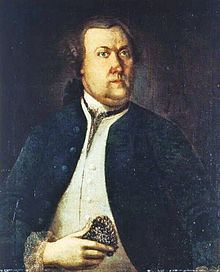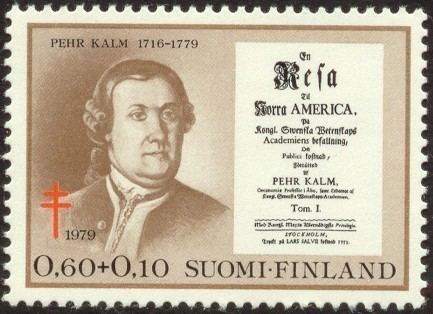Name Pehr Kalm | Role Botanist | |
 | ||
Books Travels into North America, Travels in North America Education Royal Academy of Turku (1735–1740), Uppsala University | ||
Pehr Kalm (6 March 1716 – 16 November 1779) (in Finland also known as Pietari Kalm and in some English-language translations as Peter Kalm) was a Swedish-Finnish explorer, botanist, naturalist, and agricultural economist. He was one of the most important apostles of Carl Linnaeus.
Contents

In 1747 he was commissioned by the Royal Swedish Academy of Sciences to travel to the North American colonies and to bring back seeds and plants that might be useful to agriculture. Among his many scientific accomplishments, Kalm can be credited with the description of Niagara Falls written by a trained scientist; he described this phenomenon along the border of New York (United States) and Canada. In addition, he published the first scientific paper on the North American, 17-year periodical cicada, Magicicada septendecim.
Kalm wrote an account of his travels that was translated into numerous European languages; a 20th-century translation remains in print in English as Peter Kalm's Travels in North America: The English Version of 1770, translated by Swedish-American scholar Adolph B. Benson.

Biography
Kalm was born in Angermanland, Sweden, where his parents had taken refuge from Finland during the Great Northern War. His father died six weeks after his birth. When the hostilities were over, his widowed mother returned with him to Narpes in Ostrobothnia, where Kalm's father had been a Lutheran minister.
Kalm studied at the Academy of Abo from 1735. In 1740 he entered the University of Uppsala, where he became one of the first students of the renowned naturalist Carl Linnaeus. In Uppsala, Kalm became the superintendent of an experimental plantation owned by his patron, Baron Sten Karl Bielke.
Kalm did field research in Sweden, Russia, and Ukraine from 1742 to 1746, when he was appointed Docent of Natural History and Economics at the Academy of Turku. In 1747 the Academy elevated him to Professor of Economics. That same year he was also appointed by Linnaeus and the Royal Swedish Academy of Sciences (which he had been a member of since 1745) to travel to North America to find seeds and plants that might prove useful for agriculture or industry. In particular, they wanted him to bring back the red mulberry in the hope of starting a silk industry in Finland (which was then an integral part of Sweden, today also known as Sweden-Finland).
On his journey from Sweden to Philadelphia, Pennsylvania, Kalm spent six months in England, where he met many of the important botanists of the day. Kalm arrived in Pennsylvania in 1748; there he was befriended by Benjamin Franklin and naturalist John Bartram. Kalm based his explorations at the Swedish-Finnish community of Raccoon (now Swedesboro) in southern New Jersey. This town had been founded as part of the former Swedish colony of New Sweden. There he also served as the substitute pastor of Trinity Church, the local Swedish Lutheran church. Kalm subsequently married the widow of Johan Sandin, the former pastor who had died. He remained in Raccoon until 19 May 1749.
Kalm made trips as far west as Niagara Falls and as far north as Montreal and Quebec before returning to Finland in 1751. He took a post as professor at the Turku Academy. In addition to teaching and directing students, he established botanical gardens in Turku. He taught at the Academy until his death in 1771.
Sweden and Finland had tangled histories, and often both laid claim to prominent people of the region. Kalm's ethnicity and mother tongue were a subject of discussion almost a century after his death, during Finland's so-called language strife. Kalm usually signed letters as "Pehr Kalm," in the Swedish style. He was raised in Narpes, which was then bi-cultural and bi-lingual Finland-Swedish. All his known professional writings were done in Latin and Swedish, then more widely used (especially Latin) than Finnish for scientific works. Anders Chydenius, another noted scientist from territories that later were part of Finland, was a student of Pehr Kalm's.
Legacy
A United States edition was later translated and edited by Swedish-American scholar and literary historian Adolph B. Benson (1881–1961). It was published as Peter Kalm's Travels in North America: The English Version of 1770 (Wilson-Erickson Inc., 1937). This version has become an important standard reference regarding life in colonial North America and has been in continuous print in several updated editions.
